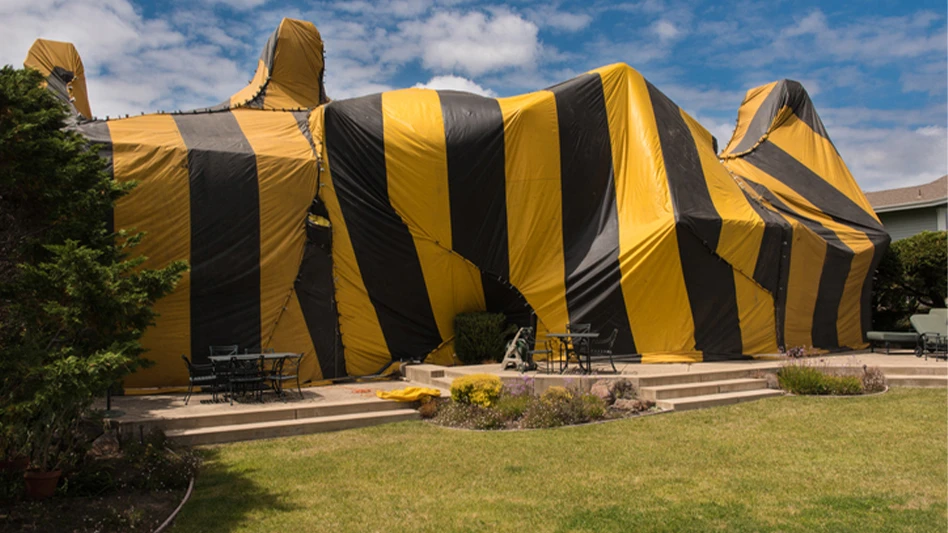
Credit: istock | ffennema
Editor’s note: This article was updated on 8/28, at 3 p.m. (EST), with additional insights from Ken Kendall, vice president of technical services and governmental affairs, for Ensystex, manufacturer of sulfuryl fluoride product Zythor gas fumigant.
WASHINGTON - On July 30, the U.S. Environmental Protection Agency (EPA) announced it approved new product labels containing additional protective measures. This is a result of the June 2023 final early mitigation decision for sulfuryl fluoride, which instructed companies to submit amended product labels that contained additional protective measures within 12 months.
The following protective measures were required as a result of EPA’s June 2023 early mitigation decision:
• Clearly posted no-entry warning signs to prevent admittance to fumigation tents throughout the fumigation process;
• Site-specific fumigation logs for residential fumigations;
• Additional registrant sponsored application stewardship training;
• Remove references to “approved” clearance devices from product labels and refer users to the EPA website, which will list the portable clearance devices determined to be effective, according to the EPA’s performance criteria; and
• Longer active and passive aeration times for residential structural fumigations.
For all sulfuryl fluoride products registered for residential use, amended labels were submitted with the revised label language, which the agency approved on July 11, 2024. The revised product labels now contain the protective measures listed above. This means that users of these products must follow the protective measures on the revised labels. Existing stocks of sulfuryl fluoride products bearing previously approved labels can be sold or distributed for 12 months from that date.
The National Pest Management Association and other industry stakeholders have been engaged in discussions with EPA and were able to obtain many changes to EPA’s initial proposals concerning warning signs and fumigation logs. These should minimize impacts to industry and consumers, according to NPMA.
One measure NPMA and industry stakeholders were unsuccessful in getting EPA to remove was the increased aeration period for residential structures from one hour to two hours.
“The residential two-hour active aeration time will require businesses to invest more resources in the labor required to maintain a longer active aeration period. From a training perspective, fumigators will need to be trained on the new product label,” said JD Darr, senior director of public policy, NPMA.
Heather Kern, vice president of global marketing, Douglas Products, manufacturer of Vikane gas fumigant (sulfuryl fluoride) agreed, noting the two-hour active aeration for residential structures may restrict the number of fumigations that fumigators in production fumigation areas, such as Florida and Hawaii, can complete in a day. “This in turn will increase costs for consumers,” she said. “Douglas Products will continue to try to reverse or mitigate the impacts of this change during the ongoing registration review for sulfuryl fluoride, which could include the development of new processes and procedures.”
At one point, it appeared EPA would prohibit the use of any clearance device that had not passed EPA’s internal tests. “Although NPMA disagrees with EPA’s assessment of ‘Not Effective Devices,’ we were pleased to see updated label language that does not require fumigators to utilize clearance devices that have been determined to be effective by EPA,” said NPMA’s Darr.
Kern said that this decision would have affected one of the most widely used clearance devices, the SF-ExplorIR. “Fortunately, Douglas Products was able to convince EPA not to prohibit the use of this device, which Douglas Products believes is reliable and accurate based on extensive testing,” she said.
The stewardship training now required by EPA is similar to what Douglas Products has been providing to fumigators who use Vikane gas fumigant, said Kern, but an important change is that there is now required stewardship training for new fumigation employees who have not previously attended stewardship training for Vikane.
Ken Kendall, vice president of technical services and governmental affairs, for Ensystex, manufacturer of sulfuryl fluoride product Zythor gas fumigant, said Ensystex’s stewardship team will be working with states to help them become more knowledgeable about what is required. “Some states are just label states — the label is the law — but in states like Florida, California and Texas, they have regulations in place and it's going to take a little bit of extra effort. Luckily, EPA modeled the new label after Florida and, in some regards, after California; EPA recognized that those are the two states that do the most fumigations. But in some states certainly it will be a bigger issue getting ready for this new label.”
Kendall added that although Ensystex was not “completely excited” about some of EPA’s new sulfuryl fluoride measures, “it gives us a roadmap to be able to make sure that we’re properly preparing operators and making sure they understand what's going to be required.”
EPA is expected to begin seeking stakeholder feedback on the traditional registration review of sulfuryl fluoride in 2026. Between now and then, NPMA will be working with manufacturers to monitor implementation of new label requirements and prepare for the upcoming registration review. Darr said NPMA is encouraging EPA to work with industry stakeholders during the upcoming registration review to develop regulation that accommodates current safe and effective business practices.
Latest from Pest Control Technology
- Donny Oswalt Shares What Makes Termites a 'Tricky' Pest
- Study Finds Fecal Tests Can Reveal Active Termite Infestations
- Peachtree Pest Control Partners with Local Nonprofits to Fight Food Insecurity
- Allergy Technologies, PHA Expand ATAHC Complete Program to Protect 8,500 Homes
- Housecall Pro Hosts '25 Winter Summit Featuring Mike Rowe
- Advanced Education
- Spotted Lanternflies, BMSBs Most Problematic Invasive Pests, Poll Finds
- Ecolab Acquires Guardian Pest Solutions





